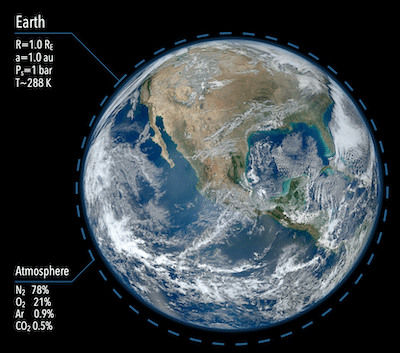Module Four: Guiding Exoplanet Missions
In Module 4 we use the combined knowledge from Modules 1–3 to guide and support NASA space missions focused on exoplanet searches and characterization. Our studies will guide target prioritization and observing strategy for NASA missions concepts and will provide important and novel tools to support the interpretation of the data from these missions — from identifying habitable planets to assessing possible signatures of life.
Methods
Exoplanet host star characterization
Exoplanet demographics
Exoplanet transits
Exoplanet population models
Exoplanet survey mission simulation
BIOSIGNATURE CONTAMINATION IN TRANSITING HABITABLE WORLDS
Project 4.1 | Lead: Benjamin Rackham
For the next two decades, exoplanet transits will be our primary probes of the atmospheres of potentially habitable planets. Transmission spectra, in particular, provide our best opportunity to identify and study atmospheres of temperate rocky planets with JWST. However, stellar photospheric heterogeneity can be an important source of contamination of exoplanet transmission spectra. By introducing a difference between the light source illuminating the exoplanetary atmosphere (the transit chord spectrum) and the reference spectrum for the differential transmission measurement (the out-of-transit full-disk stellar spectrum), stellar photospheric heterogeneity effectively imprints stellar spectral features in transmission spectra. These can mimic or mask the spectral features of exoplanetary atmospheres, thereby limiting the information gained from existing and upcoming missions. In this context, the crucial question is, “How can we disentangle stellar and planetary signals in transmission spectra from current and future facilities?”
In Project 4.1 we will (1) further our understanding of the possible range of stellar contamination for systems targeted for atmospheric follow-up, (2) develop methods to correct for the contamination (partly or fully), (3) provide input required to refine observing strategies for current and planned missions (HST, JWST, and ARIEL), and (4) provide input on optimal transmission spectroscopic capabilities for space mission concepts (e.g., LUVOIR, Nautilus) and observing strategies for future extremely large telescopes (GMT, TMT, E-ELT).


UNEARTHING THE EARTHS: TOWARD A MORE RELIABLE eta earth ESTIMATE
Project 4.2 | Lead: Ilaria Pascucci
The frequency of Earth-size planets in the habitable zone (HZ) of Sun-like stars, hereafter eta_earth, is a key parameter to evaluate the yield of nearby Earth analogs that can be detected and characterized by future missions. However, this value cannot yet be directly determined, as even Kepler, the most sensitive exoplanet mission to date, did not detect reliable Earth-sized planet candidates in the HZ of Sun-like stars (Thompson et al., 2018). As a result, h is inferred by extrapolating from the frequency of planets well interior to the HZ, where they are detected in larger numbers. However, the population of observed small, short-period planets is enhanced by the bare cores of once sub-Neptune planets whose atmosphere has photoevaporated — an atmospheric loss process that becomes too inefficient in the HZ.
Recently, we have explored the impact of stripped cores by showing that h drops by a factor of 4–8 when excluding small planets on orbits shorter than 10 to 30 days. Hence, a more reliable estimate of eta_earth requires quantifying the contamination of sub-Neptunes in the short-period/small planet population.
In Project 4.2 we will use TESS observations of young ( 100 Myr) clusters in combination with photoevaporation models to measure the frequency of primordial sub-Neptunes and thus unearth the short-period Earths, thereby greatly improving the reliability of h estimates.
BIOSIGNATURE PATTERNS IN POPULATIONS OF EVOLVING WORLDS
Project 4.3 | Lead: Regis Ferriere
The eventual success of NASA searches for life via atmospheric biosignatures will rely on our ability to distinguish — in a population of worlds — inhabited planets from sterile worlds, given constraints on the planets’ properties, including atmospheric composition. Such planetary-scale differences due to life are expected from, for example, the evolution and spread of major metabolic pathways driving global ecosystem functions (e.g., Earth’s O2-rich atmosphere). While this task is difficult, biosignature surveys will likely study populations of planets, rather than a single individual planet, making a compelling case for the use of population-level information. The presence of biosignature patterns in planet populations can bolster the positive interpretation of biosignatures for groups of planets as well as for individual worlds. Examples for such patterns are the age–oxygen trend (Figure 9) proposed by Bixel & Apai (2020b)) and the different distributions of H2-CH4-CO2 ratios in living vs. non-living planets (Affholder et al. 2020, submitted). Identifying such population-level trends will greatly increase confidence in the interpretation of biosignatures.
In Project 4.3, we will investigate biosignature patterns in simulated populations of evolving inhabited/non-inhabited worlds. We will identify testable hypotheses for future biosignature surveys. We will also predict the possible diversity of atmospheric composition and evolution with and without the biological influence of major metabolic pathways.


PROBABILISTIC ASSESSMENT OF HABITABILITY AND BIOSIGNATURES
Project 4.4 | Lead: Daniel Apai
Whereas in Project 4.3 we will assess what population-level hypotheses can be tested with biosignature surveys, in Project 4.4 we will study what quantitative constraints can be placed on individual planets, given a contextual understanding of the exoplanet population. This is important because in searches of biosignatures we will always have only very limited and uncertain information on the properties of individual planets, making it challenging to characterize these complex, unknown systems. For example, reflected light imaging will provide only relatively poor constraints on any individual planet’s size, albedo, and orbital elements.
We must, therefore, work with incomplete and uncertain information. Here we propose a path forward to combine the limited information on specific systems with firm contextual knowledge from planet formation studies and exoplanet population statistics, to provide probabilistic assessment of the target planets as envisioned in a community-supported white paper.
In Project 4.4 we will establish a self-consistent framework for quantitative, probabilistic assessment of planetary habitability and the interpretation for biosignature detections. The framework will help integrate NExSS-wide quantitative knowledge on planetary habitability.
